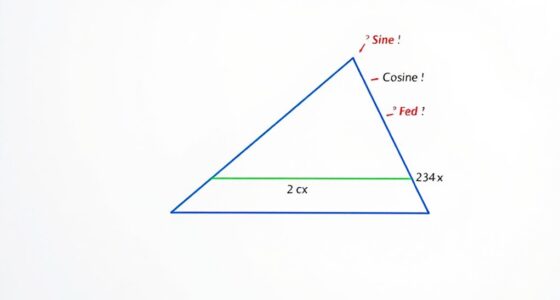To open trigonometric identities, start by understanding their geometric roots through the unit circle and the Pythagorean theorem. Recognize how sine and cosine relate to right triangles and how identities like sin²θ + cos²θ = 1 simplify your work. Visualize identities to deepen your comprehension, and practice rewriting functions using core formulas. Keep exploring these connections, and you’ll find solving problems becomes more intuitive—continuing further reveals even more essential tips.
Key Takeaways
- Understand the geometric foundation by visualizing identities on the unit circle.
- Memorize key identities like sin²θ + cos²θ = 1 to simplify problems efficiently.
- Recognize how tangent and secant relate to sine and cosine for easier conversions.
- Use the Pythagorean theorem to derive and verify various trigonometric identities.
- Practice rewriting complex functions into simpler forms using fundamental identities.

Trigonometric identities are essential tools that simplify and solve problems involving angles and functions. As you explore these identities, understanding the foundational concepts can make a big difference. One of the most effective ways to grasp trigonometric identities is through the unit circle. The unit circle provides a visual and geometric perspective that makes complex relationships more intuitive. When you look at the circle with a radius of 1, each point on its circumference corresponds to an angle, and the coordinates of that point give you the sine and cosine values directly. This geometric approach helps you see why identities like sin²θ + cos²θ = 1 hold true, as they are directly related to the Pythagorean theorem applied to the right triangles formed within the circle.
The Pythagorean theorem is a cornerstone in understanding these identities. When you analyze a right triangle inscribed in the unit circle, the theorem states that the sum of the squares of the legs equals the square of the hypotenuse. Since the hypotenuse in the unit circle is always 1, the relationship simplifies to x² + y² = 1, where x and y are the coordinates of the point on the circle. Recognizing this connection allows you to see why the fundamental identity sin²θ + cos²θ = 1 is valid for all angles. It’s not just an algebraic trick; it’s rooted in geometry, which makes it easier to remember and understand.
As you work through trigonometric problems, keep in mind that identities often serve as shortcuts to simplify expressions or to rewrite complex functions in more manageable forms. For example, when you encounter tangent or secant functions, relating them to sine and cosine can help you rewrite and simplify expressions. Using the unit circle as a reference point makes these conversions more straightforward, especially since tangent is sine over cosine, and secant is the reciprocal of cosine. These relationships become clearer when you visualize the circle and recall the Pythagorean theorem, which ties everything together. Additionally, understanding the geometric foundations of these identities can deepen your comprehension and aid in memorization.
In practice, mastering these identities involves recognizing patterns and understanding their geometric foundations. By consistently referencing the unit circle and recalling the Pythagorean theorem, you’ll find it easier to verify identities and solve trigonometric equations. This geometric perspective not only deepens your comprehension but also boosts your confidence when tackling more advanced topics. Remember, these identities aren’t just formulas to memorize—they’re tools rooted in geometry that, once understood, reveal a deeper understanding of the relationships between angles and functions.
Frequently Asked Questions
How Do I Memorize All the Trigonometric Identities Effectively?
To memorize all the trigonometric identities effectively, you should use mnemonic devices to make recall easier and create visual aids like charts or diagrams to see relationships clearly. Repetition helps reinforce your memory, and practicing problems solidifies your understanding. Break down complex identities into simpler parts, and regularly review your mnemonic devices and visual aids to keep everything fresh in your mind. This approach makes learning identities more manageable and fun.
Are There Common Mistakes Students Make When Applying Identities?
When applying identities, you might fall into common pitfalls like mixing up reciprocal, quotient, or Pythagorean identities. You may also make errors in algebraic manipulation or forget to verify your work. To avoid these mistakes, double-check each step, guarantee your substitutions are correct, and practice error correction. Recognizing these pitfalls helps you develop accuracy and confidence in solving trigonometric problems efficiently.
How Can I Verify if an Identity Is True or Not?
Verifying an identity is like being a detective solving a mystery—you need to find the truth. To verify an identity, start with algebraic manipulation, simplifying both sides to see if they match. Use substitution to test specific values for variables; if both sides are equal for multiple values, the identity likely holds. Always double-check your steps to catch any mistakes and confirm the identity’s validity.
What Are the Best Resources for Practicing Trigonometric Identities?
When practicing trigonometric identities, you should explore interactive quizzes and online tutorials. These resources help you test your understanding actively, providing instant feedback and explanations. Interactive quizzes challenge you to solve problems, while online tutorials walk you through step-by-step solutions. Combining both guarantees you grasp concepts deeply and improve your skills efficiently, making your study sessions engaging and effective.
How Do Identities Differ Between Degrees and Radians?
When you explore identities, you’ll notice they differ between degrees and radians through angle conversion and measurement units. Degrees measure angles in 360 parts, while radians measure in terms of the radius and arc length. To switch between them, you convert using the relation: 180° equals π radians. Understanding this helps you recognize how identities adapt, making your calculations more accurate across different measurement units.
Conclusion
Mastering trigonometric identities might seem tricky at first, but with practice, you’ll find it gets easier. Remember, every expert was once a beginner, so don’t throw in the towel when things get tough. Keep working through problems, and you’ll soon see the light at the end of the tunnel. The key is to stay persistent and keep your eye on the prize. With patience and effort, you’ll discover these identities like a pro in no time.









